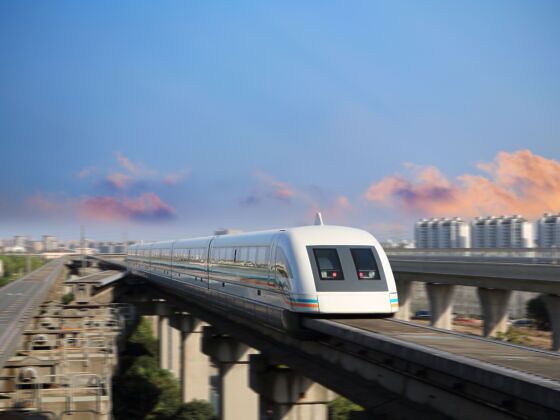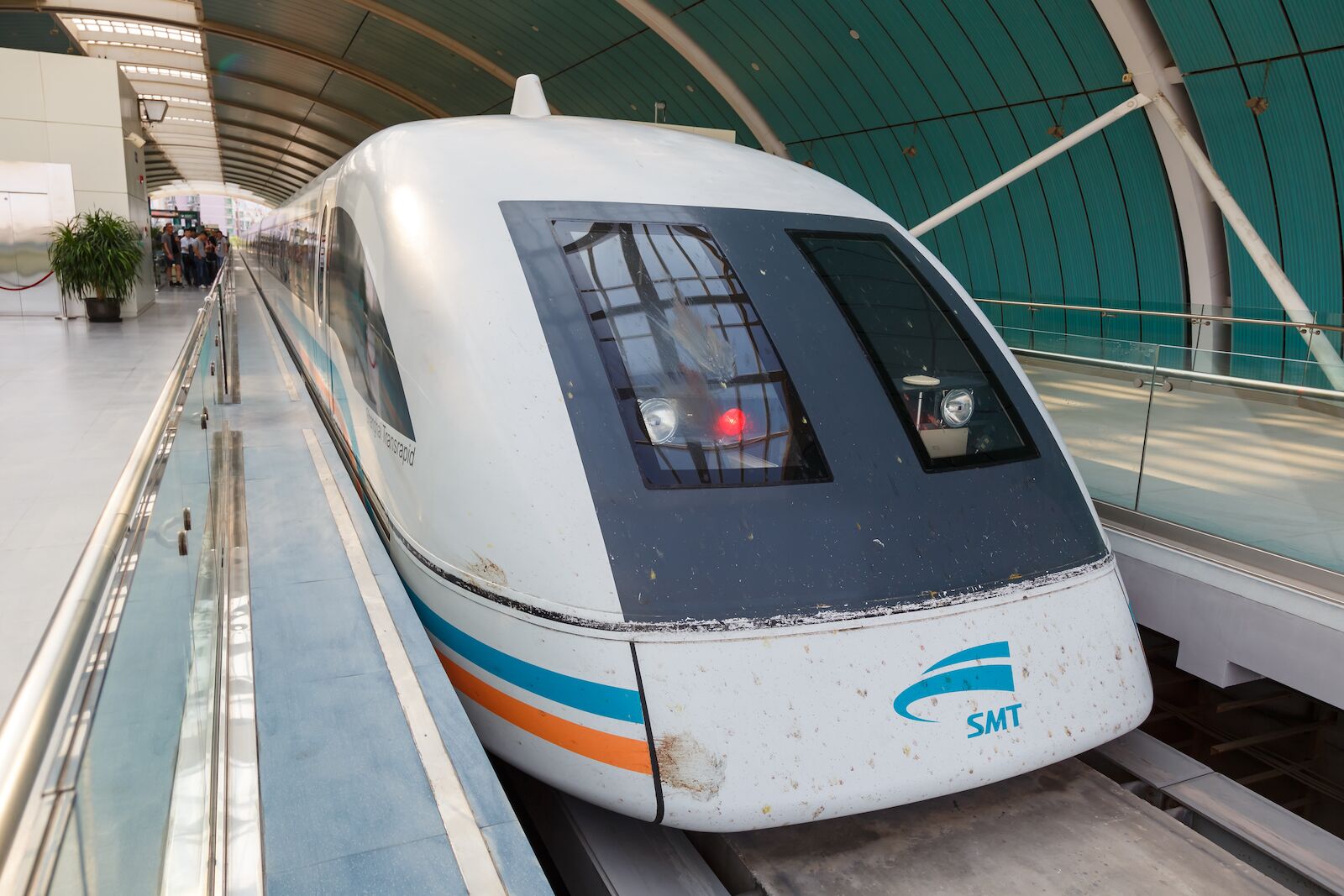There are high-speed trains and then there are high-speed maglev trains. While there are plenty of examples of the former (in the UK, in Spain, in France and even in Florida), only one of the latter is in commercial operation today: The Shanghai Maglev Train (SMT), also known as the Shanghai Transrapid Maglev Train. This unique train runs between Shanghai Pudong International Airport and the Shanghai’s financial district every 15 minutes and is the fastest commercial train in the world.

Everything You Need to Know to Ride the World's Fastest Passenger Train
- How fast is the maglev train from Shanghai airport?
- Shanghai Maglev Train map
- Is the Shanghai Maglev the fastest train in the world?
- How much is the maglev train in Shanghai?
- Is the Shanghai Maglev Train profitable?
- Where else in the world can I ride a maglev train?
- what is a maglev train?
- How do maglev trains work?
- Are maglev trains safer?
- What is one disadvantage of maglev trains?
- How do maglev trains stop?
How fast is the maglev train from Shanghai airport?
On its 18-mile route between Shanghai Pudong International Airport (PVG) and the city’s financial district, the Shanghai Maglev Train reaches a top speed of 267.8 mph and makes the trip in just eight minutes.
Shanghai Maglev Train map
The Shanghai Maglev Train only runs one non-stop route: Between the Shanghai Pudong International Airport and the Longyang Road Station in the financial district of Shanghai.
Is the Shanghai Maglev the fastest train in the world?
Yes, the Shanghai Transrapid Maglev Train is the fastest commercial train in the world and holds the Guinness World Record for being the “fastest maglev train in regular public service”. That said, is not the fastest maglev train in the world. That title goes to the SCMAGLEV of the Central Japan Railway Company which runs at a top speed of 374.68 mph. The SCMAGLEV train is not a commercial passenger train, it is at the testing stage.
How much is the Maglev train in Shanghai?
A one-way, standard-class ticket to ride the Shanghai Transrapid Maglev Train costs $7 (50 Chinese Yuan); a round-trip, standard-class ticket costs $11.20 (80 Chinese Yuan).
A one-way, first-class ticket costs $14 (100 Chinese Yuan); a round-trip, first-class ticket costs $22.40 (160 Chinese Yuan). (First-class ticket on the Shanghai Transrapid Maglev Train are known as “VIP tickets”.)
Tickets are sold in vending machines both at the airport and at the Longyang Road Station.
Is the Shanghai Maglev Train profitable?

Photo: Markus Mainka/Shutterstock
According to an article published in The Guardian in May 2018, Shanghai’s maglev train loses between 600 and 700 million Chinese Yuan per year, i.e. between 84 and 98 million US dollars per year.
Where in the world can I ride a maglev train?
There are maglev trains in only three countries around the world:
- China: The Shanghai Maglev Train, the Changsha Maglev, and the Line S1 of the Beijing subway system.
- Japan: The Linimo line that runs for 5.6 miles in the city of Toyota in the Aichi Prefecture.
- South Korea: The Korean Rotem Maglev that runs in the city of Taejeŏn, and the Inch’ŏn Airport Maglev that runs from Inch’ŏn International Airport to the Yongyu station, a distance of 3.8 miles.
Shanghai’s maglev is the only operational commercial high-speed maglev train in the world at time of writing. The other maglev trains noted above are low or medium-speed maglev trains.
What is a maglev train?
A maglev train is one that uses magnetic levitation technology. Instead of running along rails like regular trains, maglev trains levitate above a special-built guideway thanks to magnets.
How do maglev trains work?
There are two types of maglev trains: Those who use Electromagnetic Suspension (EMS) and those who use Electrodynamic Suspension (EDS). The maglev in Shanghai uses EMS while Japan’s SCMAGLEV, still at the testing stage, uses EDS.
Maglev trains that use EMS levitate thanks to electromagnets of similar poles fitted under the train and on the bottom of the T-shape guideway the train travel along. The magnets repel each other, thus creating a gap between them and allowing the train to stay suspended.
Maglev trains that use EDS levitate within their U-shaped concrete guideway thanks to superconducting magnets fitted on the side of the trains and coils set up in the walls of the guideway. When the train runs at high speed, the coils react to the superconducting magnets and generate a magnetic force that allows for the train to levitate and remain at a stable height and distance from the guideway.
EMS and EDS trains are propelled forward using very similar technology: The guideway they are in are equipped with electromagnets powered with alternating current and set at regular intervals. The poles on these electromagnets are switched between north and south rapidly, and when they react to the poles of the magnets that are fitted the side of the train, it propels the train forward. The may difference is that Japan’s SCMAGLEV uses superconducting magnets, instead of regular electromagnets. Superconducting magnets create much stronger magnetic fields than regular electromagnets.
Are maglev trains safer?
Maglev trains are considered safer from derailment than regular trains. The magnetic force that is generated keeps the train in place in the guideway at all times, even in tight corners.
What is one disadvantage of maglev trains?
Maglev trains are costly to build and requires specific infrastructures (the trains’ special guideways, tunnels, etc.) that also cost millions, if not billions, and that are not compatible with existing ones. Countries that have an existing, well-functioning and extensive railway network are unlikely to switch to maglev trains soon.
How do maglev trains stop?
By reversing the way the electromagnets in the guideway and in the train are used to propel the vehicle, the train slows down and stop.
Japan’s SCMAGLEV has drag panels that can be deployed on the exterior of the train to reduce the aerodynamics of the vehicle and allow it to decelerate. It also has disc brakes fitted to its wheels that create friction and cause deceleration. Both systems are only used in case of emergencies. (Note that the SCMAGLEV does have wheels that retract after the train has achieved a certain speed and is levitating.)